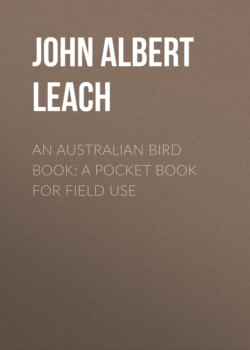Читать книгу An Australian Bird Book: A Pocket Book for Field Use - John Albert Leach - Страница 10
На сайте Литреса книга снята с продажи.
A LECTURE.
ОглавлениеTable of Contents
Australia is the wonderland of the scientist and of the Nature-lover. It is a great living "museum," stocked with marvels of many kinds, including so-called "living fossils," the sole survivors of otherwise extinct groups of animals.
Competent authorities have proposed to divide the world, biologically, into two parts—Australia and the rest of the world, and they have considered Australia the more important part.
This division was based mainly on the study of mammals—animals which suckle their young—for Australia is the home of the two surviving members of the lowest group of mammals—Monotremata, the egg-laying Platypus (Ornithorhynchus), and the Spiny Ant-eater (Echidna). Further, marsupials, except for two kinds found in America, are confined to this long-isolated southern land.
Here, shut off from the severe competition experienced by the animals of northern lands, marsupials were modified so that they were adapted for life in almost every realm utilized by the higher mammals of other countries. Thus there are herbivorous, carnivorous, and insectivorous marsupials. Owing, probably, to the advent of Bats—true flying mammals—at, possibly, a comparatively early time, the marsupial was beaten in the air, and so a true flying form was not evolved, though the so-called "Flying Phalanger" is some distance on the way.
As regards the other group of flying animals—birds—Australia is even of greater interest, for here are found unique archaic forms of life, such as the Emu, Cassowary, Mound-Builders, and Lyre-Birds, and "every widely-spread family of birds but two is represented; the only widely-spread families of birds totally absent from Australia are Woodpeckers and Vultures." Woodpeckers, however, have crossed Wallace's line into Celebes and adjacent islands, and may yet reach Australia naturally.
Further, many well-known birds, such as Pigeons, Parrots, and Kingfishers, reach their highest development in the Australian region, and, more important still, the whole bird world seems to reach its culminating point in this wonderland. It is a factor adding to the interest of Australia's fauna that three of the four families placed at the head of the bird world in the natural system of classification adopted by ornithologists, and used by Dr. Sharpe in his just recently completed Hand-List of Birds, should be absolutely confined to the Australian Continent and adjacent islands. Thus Australia can justly claim to be the most highly developed of regions, so far as birds are concerned, for Bower-Birds, Birds of Paradise, and Bell-Magpies (Streperas) are peculiar, while the penultimate family—the Crow family—is shared with the other regions of the world.
Thus, with regard to birds, the term "fossil continent" applied to Australia is not appropriate, as it is but partly true.
Since the birds native to Australia are so interesting in themselves, and are so varied in kind, Australians should know, love, and jealously protect these beautiful creatures. Strict regulations should be framed to prevent the exploitation of Nature's gifts by those who destroy useful or precious and rare birds for the sake of gain. Even collectors, who, under the guise of scientific work, collect eggs, and kill birds to trade in their skins, should be supervized.
Let us now consider the different groups of birds. Living birds were formerly divided into two sub-classes—(1) Ratitae (Lat., ratis, a raft), and (2) Carinatae (Lat., carina, a keel). The first is the small group of flightless, running birds, made up of five living birds, all inhabiting southern lands. These are the Emu and Cassowary of Australia, the Ostrich of South Africa, the Rhea or South American Ostrich, and the Kiwi or Apteryx of New Zealand. Taken together with other evidence, all pointing in the same way, these birds have led scientists to think of a great southern land mass connecting the southern lands, for the Emu did not fly here, nor did the Rhea fly to South America, but they must have reached their present home by a land-bridge not necessarily complete at any one time. As these birds do not fly, they have no big wing-muscles, and so do not need the ridge of bone down the breast. Thus they belong to the sub-class, the members of which have a raft-like breast bone. The other living birds were placed in the sub-class the members of which have a keel on the breast bone for the attachment of the wing-muscles.
Recently, however, Pycraft, a leading ornithologist, has proposed to base the division into sub-classes on the characters of the bones of the palate instead of those of the breast-bone. Thus, he places the sixth family of birds—the Tinamous, of South America—with the ratite birds, to form his primitive group—Palaeognathae ("old jaw"), while the members of the old sub-class Carinatae, minus the Tinamous, constitute his second division, the Neognathae ("new jaw").
Mr. Gregory Mathews, the first part of whose projected great work on Australian Birds has just come to hand, has followed Dr. Bowdler Sharpe in accepting this classification, so we must follow too, as Mathews' work will probably be our standard for years to come. The large number of Australian birds belonging to this second sub-class is now divided into 20 orders, which with the Emu order, make a total of 21 orders of birds represented in Australia.
Now, let us consider the birds in each order. The best-known member of the first Australian order is the Emu, a bird well known to all, though, unfortunately, becoming very rare, so that few persons in the settled districts now enjoy the privilege of seeing an Emu in a wild state.
